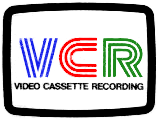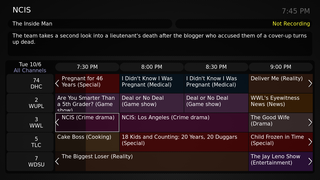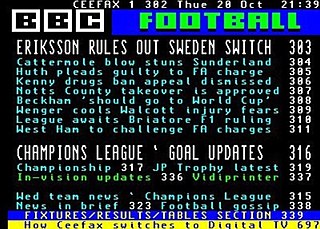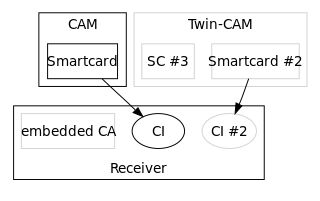
Closed captioning (CC) and subtitling are both processes of displaying text on a television, video screen, or other visual display to provide additional or interpretive information. Both are typically used as a transcription of the audio portion of a program as it occurs, sometimes including descriptions of non-speech elements. Other uses have included providing a textual alternative language translation of a presentation's primary audio language that is usually burned-in to the video and unselectable.

VHS is a standard for consumer-level analog video recording on tape cassettes invented in 1976 by the Victor Company of Japan and was the competitor to the ill-fated Sony Betamax system.

Digital Video Broadcasting (DVB) is a set of international open standards for digital television. DVB standards are maintained by the DVB Project, an international industry consortium, and are published by a Joint Technical Committee (JTC) of the European Telecommunications Standards Institute (ETSI), European Committee for Electrotechnical Standardization (CENELEC) and European Broadcasting Union (EBU).

S-VHS (スーパー・ヴィエイチエス), the common initialism for Super VHS, is an improved version of the VHS standard for consumer-level video recording. Victor Company of Japan introduced S-VHS in Japan in April 1987, with their JVC-branded HR-S7000 VCR, and in certain overseas markets soon afterward. By the end of 1987, the first S-VHS VCR models from other competitors included Hitachi VT-2700A, Mitsubishi HS-423UR, Panasonic PV-S4764, RCA VPT-695HF, and Toshiba SV-950.
Digital Video Broadcasting – Satellite (DVB-S) is the original DVB standard for satellite television and dates from 1995, in its first release, while development lasted from 1993 to 1997. The first commercial applications were by Star TV in Asia and Galaxy in Australia, enabling digitally broadcast, satellite-delivered television to the public. DVB-S was the first DVB standard for satellite, defining the framing structure, channel coding and modulation for 11/12 GHz satellite services.
Near Instantaneous Companded Audio Multiplex (NICAM) is an early form of lossy compression for digital audio. It was originally developed in the early 1970s for point-to-point links within broadcasting networks. In the 1980s, broadcasters began to use NICAM compression for transmissions of stereo TV sound to the public.

Video Cassette Recording (VCR) is an early domestic analog recording format designed by Philips. It was the first successful consumer-level home videocassette recorder (VCR) system. Later variants included the VCR-LP and Super Video (SVR) formats.
HD-MAC was a broadcast television standard proposed by the European Commission in 1986, as part of Eureka 95 project. It belongs to the MAC - Multiplexed Analogue Components standard family. It is an early attempt by the EEC to provide High-definition television (HDTV) in Europe. It is a complex mix of analogue signal, multiplexed with digital sound, and assistance data for decoding (DATV). The video signal was encoded with a modified D2-MAC encoder.
3GP is a multimedia container format defined by the Third Generation Partnership Project (3GPP) for 3G UMTS multimedia services. It is used on 3G mobile phones but can also be played on some 2G and 4G phones.

Electronic programming guides (EPGs) and interactive programming guides (IPGs) are menu-based systems that provide users of television, radio and other media applications with continuously updated menus that display scheduling information for current and upcoming broadcast programming. Some guides also feature backward scrolling to promote their catch up content. They are commonly known as guides or TV guides.
MPEG transport stream or simply transport stream (TS) is a standard digital container format for transmission and storage of audio, video, and Program and System Information Protocol (PSIP) data. It is used in broadcast systems such as DVB, ATSC and IPTV.

Teletext, or broadcast teletext, is a standard for displaying text and rudimentary graphics on suitably equipped television sets. Teletext sends data in the broadcast signal, hidden in the invisible vertical blanking interval area at the top and bottom of the screen. The teletext decoder in the television buffers this information as a series of "pages", each given a number. The user can display chosen pages using their remote control. In broad terms, it can be considered as Videotex, a system for the delivery of information to a user in a computer-like format, typically displayed on a television or a dumb terminal, but that designation is usually reserved for systems that provide bi-directional communication, such as Prestel or Minitel.

In Digital Video Broadcasting, the Common Interface is a technology which allows decryption of pay TV channels. Pay TV stations want to choose which encryption method to use. The Common Interface allows TV manufacturers to support many different pay TV stations, by allowing to plug in exchangeable conditional-access modules (CAM) for various encryption schemes.
Program-specific information (PSI) is metadata about a program (channel) and part of an MPEG transport stream.
Packetized Elementary Stream (PES) is a specification in the MPEG-2 Part 1 (Systems) (ISO/IEC 13818-1) and ITU-T H.222.0 that defines carrying of elementary streams (usually the output of an audio or video encoder) in packets within MPEG program streams and MPEG transport streams. The elementary stream is packetized by encapsulating sequential data bytes from the elementary stream inside PES packet headers.
Service Description Table (SDT) is a metadata table used in Digital Video Broadcasting systems to describe the television, radio or other services contained in MPEG transport streams provided by the system. The purpose and format of the table is defined in ETSI EN 300 468: Specification for Service Information (SI) in DVB systems.
Timed Text Markup Language (TTML), previously referred to as Distribution Format Exchange Profile (DFXP), is an XML-based W3C standard for timed text in online media and was designed to be used for the purpose of authoring, transcoding or exchanging timed text information presently in use primarily for subtitling and captioning functions. TTML2, the second major revision of the language, was finalized on November 8, 2018. It has been adopted widely in the television industry, including by Society of Motion Picture and Television Engineers (SMPTE), European Broadcasting Union (EBU), ATSC, DVB, HbbTV and MPEG CMAF and several profiles and extensions for the language exist nowadays.
This article covers technical details of the character encoding system defined by ETS 300 706, a standard for World System Teletext, and used for the Viewdata and Teletext variants of Videotex in Europe.
The Service List Registry (SLR) provides an online directory of audiovisual services, based on open standards for Digital Video Broadcasting. The Service List Registry enables any compatible client device or application to query a distributed online database to retrieve lists of relevant media services and obtain technical details of how to access them over various delivery networks.








